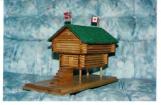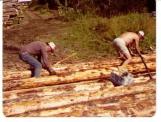1
Newspaper Clippings from 1976 about Norwegian Club plans to build Laft Hus1976
Red Deer, Alberta, Canada

2
Laft Hus - Front Entrance in Spring Time1980's
Heritage Square, Red Deer, Alberta
 Credits:
Credits:Norwegian Laft Hus Society
3
Newspaper Clippings 1976 about Norwegian Club and Norse Style Dishes at BanquetRed Deer, Alberta, Canada
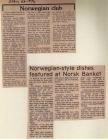
4
The Building of the Laft Hus - Part 1Central Alberta, Canada
The Building of the Laft Hus
Building Funds Started
Some profits from each club event were earmarked for the proposed building and by December 1976, the first $500 was raised for this fund. By February 1978 the building committee had researched enough typical Norwegian architecture to decide that their building would definitely be made of logs. This club did many things to raise funds fromstaging the first few annual lutefisk suppers, to catering at the first few Red Deer Airshows, to going out to the west country to harvest cord wood for resale.
Logs Donated
When Norman and Eunice Langvand of Caroline, Alberta joined the club, they generously donated the first fifty logs for the building and their acreage home site on which to start work on them. They, along with a few other members, such as Cliff and Laura Hanson and Brian Grosseth, also loaned their own money at little or no interest charges, to assure that the building project could buy the initial tools and supplies.
Norwegian Log Joiner in the Area
Eunice Langvand also discovered a log builder from Norway teaching log-joining ("lofting") at Southern Alberta Institute of Technology (SAIT). Jan Saetre happened to be holding a public demonstration of his work on an actual log building display at the Corral, at Calgary's Stampede groundes. He had learned this ancient craft from his father and grandfather on his family's tree farm in Trysil, Norway. Eunice organized a field trip for a group of members to visit him in Calgary. His guidance throughout the project assured the integrity of this Norwegian Laft Hus, log house! "Do you know what you folks are undertaking?" he aksed when he heard our plan. "No, but we will do it anyway!" we replied. "Then I will help you all I can!" was his quick response.
Log Preparation
By the spring of 1978 the first of many weekend work parties were organized as family fun camp-outs to remove the bark and plane the logs. Draw knives, spuds, adzes and planers were purchased or borrowed, allowing everyone to learn how to prepare logs for this Norwegian building.
The first donated and planed logs proved too small for the size of the eventually decided-upon building. They were sold and bigger pine logs purchased. Before the new logs were prepared, however, a contract was made by the club with Mr. Saetre to prepare yet another set of logs for his log-building company, in order to raise more funds for the Laft Hus project.
After the bark and knots were scraped off, each log was deliberately "cracked" or partially power-sawed down the entire length then "wedged" by driving pre-made wooden wedges into this crevice in an attempt to control future log cracking. The cracked side would eventually be shaped and placed directly over the next log below it. Then each log was power and hand planed to a smooth finish. Finally, they were preserved in the old Norwegian tradition with coatings of pine tar until volunteers could proceed to the next phase.
Though successful in the more humid Norwegian weather, the pine tar did not hold up in the relatively dry Alberta climate. Eventually it was removed and replaced with a modern wood stain and varnish. Since the completion of the Laft Hus these same products have been used regularly to prevent the log exterior from deterioration.
Who was the Leader?
The building committee appointed Stan Wulff as Building Project Coordinator throughout the building process. Every successful project needs a dedicated and skilled leader and Stan's skills in project planning, attention to detail and volunteer supervision proved a good mix for the project.
Many Helped in Many Ways
During the years of researching, building and fundraising many people came forward offering special gifts and assistance. One of these was Oivind Arne Madssen, a newspaper editor from Odda, Norway, Mr. Madssen came to Red Deer in September 197u6 doing a research project for the Norwegian Newspaper Association. At the same time he took the opportunity of meeting with and writing about as many people of Norwegian birth and descent in the area as possible. Oivind Madssen became a close friend and benefactor of the club and has been a valuable contact in Norway
over the past thirty years. Many gifts of artifacts, cultural resource books and other forms of assistance were received from the Madssen family. The gift of "Grunnmurplate" (special waterproof sod-roof underlay material) from the factory which produces it in Notodden, Norway was obtained by the Madssens. (This material now called "Platen" and commonly used in Alberta as a vapour barrier for basements in building construction.)
Credits:
Betty Wulff - for written accounts of the building of Laft Hus
6
Wooden Model of Laft Hus Building1980's
Heritage Square, Red Deer, Alberta
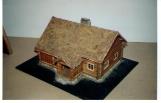 Credits:
Credits:Norwegian Laft Hus Society
7
Model of Laft Hus1980's
Red Deer, Alberta, Canada
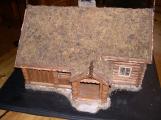 Credits:
Credits:Mary Vanson made this model of Laft Hus (in Red Deer, AB) before it was built
9
Logs for Laft Hus - Workers remove bark from logs1970's - early 1980's
Central Alberta, Canada
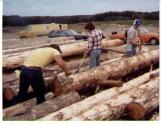 Credits:
Credits:Norwegian Laft Hus Society
10
The Building of the Laft Hus - Part 2Central Alberta, Canada
The Building of the Laft Hus - Part 2
Sval
In Norway, a house is traditionally positioned facing south, with a sort of porch, called a "sval" running around two or more sides. This sval acted as a weather buffer, storage area or military protection and sometimes it ended in a privy. Particularly if there was a second-story level, the sval served as a fortification with fancy carved looholes through which the defenders could shoot their long bows and later their muskets, in the oft-recurring wars with whish Norway was plagued.
The Laft Hus was directed by the City of Red Deer to place its sval facing north due to the other small buildings configured into the same site. The construction of the sval on the north and east sides, follows the design of the original house.
Laft Hus Sval Pillars
Norwegian Club member, Clifford Hanson of Red Deer, originally from Caroline, Alberta, designed his own lathe and shaped the beautiful exterior pillars supporting the "sval" which embraces two exterior walls of the Laft Hus. He is pictured working on these pillars and later taking a short rest from the Scandinavian folk dancing which he and his wife, Laura, were passionate about. Cliff, whose father had emigrated from Norway, became interested in his roots and, with his wife, and several others from the region, attended folk dance festivals in Norway. While there he studied the actual log house from which the Laft Hus was patterned as it still stands, preserved in an outdoor folk museum in that country. This coupleand many other couples made remarkable volunteer contributions to the building project. Paul Ritchie, is seen in one of these photos, filling small cracks in the log pillars. His wife, Mary Sjare Jones Ritchie, was instrumental in planning the interior furnishings for the Laft Hus, and with her needle and thread, sewed many of the linens. Wool embroidered wall hangings, curtains, bed and table linens were her specialty.
Continued Work on Logs Closer to Red Deer
In the spring of 1981 the third and final set of logs were delivered to a new temporary building work site, compliments of the property owner, Lesley Wadey. This site, beside dhte Blindman River, was a short distance north of the City of Red Deer, and more accesible to most club members. Weekend and evening work parties to prepare the logs became more frequent. Competitions were held to see who could plane the most logs by a pre-set date and it was a rare evening when no one was on site at work on the logs. Young and old worked together.
Jan Saetre ("Setre" in Canada) who had moved from Calgary to an acreage in the nearby County of Lacombe, was contracted to do the actual "lafting" (log joining). He was assisted by various interested club volunteers who wanted to learn the old methosds of NOrwegian log joinery from the expert. This method involved each log being hand-scribed and cut to shape the log below it. Chinking is not necessary to fill in cracks between logs, such as was often done on many log homes built by early settlers in westerdn Canada, simply because there are no cracks to fill. Even a sharp knife could not be fitted between the Norwegian-fitted logs. As another modern substitute for the red or green homespun or mass in old Norwegian homes, fiberglass batting between each log seam was an added insulating feature.
The building walls and roof framing were completed on the temporary site for later dismantling, moving and completing on a permanent site.
A Permanent Site
The Laft Hus representative, Betty Wulff, who had coordinated the site search, initially sought a site at the then current Mayor's suggestion, on the newly relocated Westerner grounds. This was not available as space for their own plans were at a premium and they were not ready to accomodate space for a whole international village of buildings. Her committee then presented the Laft Hus project to the Recreation Department, who, after giving their support, took their recommendation to City Council for approval. The City of Red Deer concluded at teh September 17th, 1984 Council meeting that the Laft Hus would be located and finished in the City of Red Deer's Heritage Square, Rotary Recreation Park. At this meeting Betty thanked them, on behalf of the Norwegians, noting that this was a "temporary site" but asked if enough space for any other countries' buildings could eventually be made available in the future. She reminded them about the original overall purpose for building the Laft Hus and the CIty's long-held dream to build an International Village.
City Council's response was hopeful and promising: "If your group continue your goals as promised and if enought other similar groups come forward with a building plan as attractive to visitors such as yours, with as much promise to serve the City of Red Deer by augmenting our communitiy's cultural programs for the citizens of this area, we will then take up the old dream of this theme village again by finding a large enough site on which to stage this village."
To date too many City of Red Deer expansion costs have had to take priority. A formal agreement was duly agreed upon and signed by the Laft Hus Society and the City of Red Deer with strict guidelines regarding the management and operation of the norwegian Laft Hus. In essence the Laft Hus Society pledged to first and foremost be of service to the community and carefully follow any guidance from teh City of Red Deer.
Plans were finally made to relocate and finish the Laft Hus at Heritage Square.
With volunteer help, Jan Saetre dismantled the log building by the Blindman River, numbering the logs for re-construction while Dwayne Tronnes, of Bonanza Movers, also a Laft Hus club member and proud second-generation Norwegian, was responsible for moving the dismantled building to Heritage Square. A temporary workmen's shack witha wood stove, was erected by club members with temporary power installed to the site by Triple A Electric owner, Mal Hough, whose ancestors also hailed from Norway.
Before the partially build Laft Hus could be erected in Heritage Square however, the City's structual engineers dictated that massive wooden pilings must be installed in the ground due tothe projected weight of the building. This was due to the instability of the underlying type of earth-fill on the designated spot, as it had originally been a large swampy area. Without this underlying security measure the building's stability could have been jeopardized. Thirty-five foot long by 12" diameter, creosote-treated timber pilings were pile-driven into the earth before a three foot crawl space could be accommodated over them and under the foundation.
A discussion and tentative plan about a possible basement under the house and access to City running water from 47th Avenue on the east of Heritage Square were quickly abandoned due to this unexpected new structural expense. Next came the creosote-treated 10"x16" fir beams the length of the Laft Hus as a massive log foundation. These were salvaged from an old railroad bridge and secured over the pilings around the building perimeter and down the center. Joists were made of smaller logs, flattened top and bottom to 6" and hung on specially made heavy metal hangars which were fastened to the large beams.
Directly over the joists went 2" x 6" tongue and groove pine flooring boards, glued one to another as had been done in the Numedal house. Grooves were cut along the interior wall bases into which the flooring could be loosely placed to allow for the give and take of overall shrinkage as it was the method in Norway. The floor boards, like those on the ceiling, were finished with a wash of lime and lye solution to bleach them in the traditional Norwegian manner. Then the floor was washed with a specially made brown liquid natural soap called "Faxe" especially made for such after treatment and cleaning of lye-treated wood. Due to the pressing official opening date of the building these floor boards did not get enought repeated washes of this soap to replicate the Norwegian-type stain-resistant floor finish. Twenty some years later after this "floating" floor boards began to heave and separate, due to the quickly changing Alberta climate, a new Alberta-type floor replaced the Norwegian one.
Credits:
Betty Wulff, wrote chronicles of the building of the Laft Hus
11
Stan Wulff, Laft Hus Project Chairman, Planing Logs in preparation for building Laft Hus1980's
Central Alberta, Canada
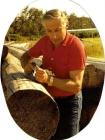 Credits:
Credits:Norwegian Laft Hus Society
12
Jan Saetre Doing Log Joining for the building of the Laft Hus1980's
Central Alberta, Canada
 Credits:
Credits:Jan Saetre
Norwegian Laft Hus Society
13
Building at Blindman river site1980's
Blindman River Site, Alberta, Canada
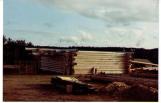 Credits:
Credits:Norwegian Laft Hus Society
14
Paul Ritchie Interview about Log Building2007
Blindman River Site, Alberta, Canada
 Credits:
Credits:Paul Ritchie (Interviewee)
Betty Wulff (Interviewer)
